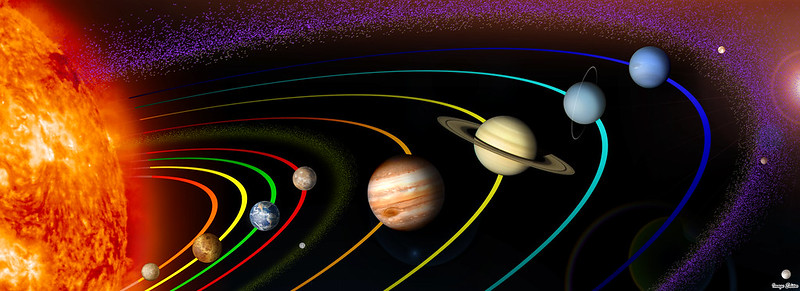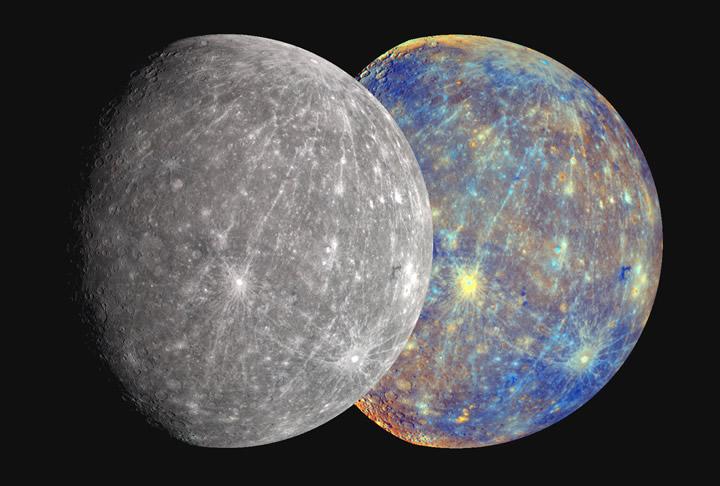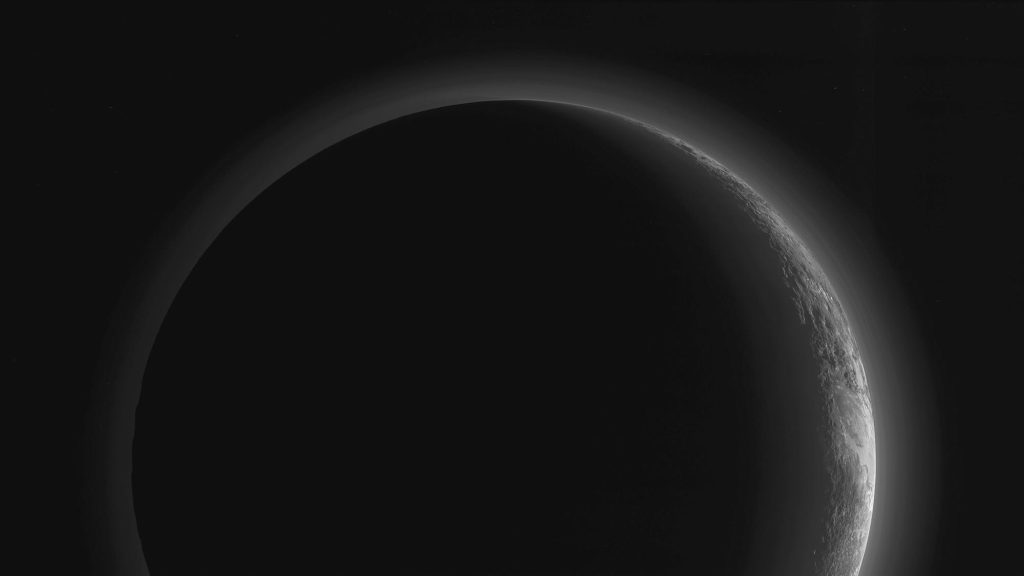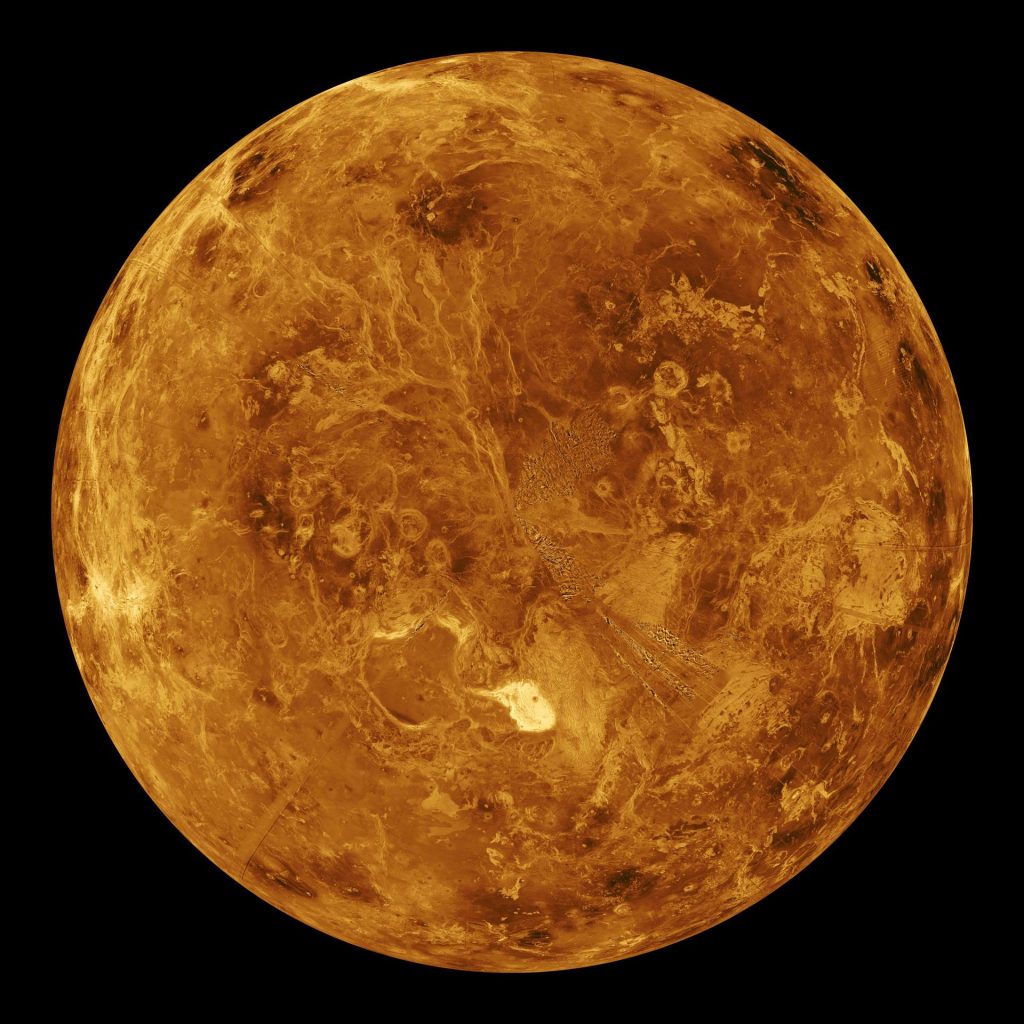Last updated on December 18th, 2023
The Sun, also known as a star, is the center point of the solar system where the Earth, home to humans, is located. In ancient times, people considered some objects, like the Sun and the Moon, powerful beings living in the sky. Then, curious people through the ages started studying those objects and discovered them for what they were. The name of our solar system is derived from the Sun, called solar, or the ancient Latin word ‘Solis.’ Millions of the same systems as ours can be found in the universe and are called star systems. Our solar system has many other objects other than the planets and moons. Millions of asteroids, meteoroids, and comets can be found in our solar system’s vast space. With these facts about the Solar System, let us learn about it.
Facts about Solar System
Age!
1. According to cosmologists worldwide, our solar system was formed about 4.5 billion years ago. Cosmology is a physical science and a branch of astrophysics that studies the universe’s evolution.
The Birth of the Sun
2. The Sun was the first object formed from this cloud of solar dust and particles. Cosmologists say that the Sun was formed from this solar nebula when the cloud collapsed under its gravity.
The collapse
3. A shockwave caused by a nearby supernova explosion was most likely the reason the collapse started. Other objects like the planets and moons may also have formed from this cosmological event.

The process of formation
4. According to scientists from different disciplines, it all started with this cloud of dust created by leftover particles from supernovas. But the process of forming these star systems takes billions of years.
The binding force
5. Gravity is the glue that keeps everything in our solar system together. Because the Sun is the biggest object in the solar system, it also has the most substantial gravity and keeps everything else in position.
Around the Milky Way!
6. It will take our solar system about 230 to 250 million years to complete one orbit around the center of the Milky Way. Just like Earth orbits the Sun, so does our solar system orbit the center of our galaxy at about 515,000 mph (828,000 kph).
Earth day
7. We celebrate Earth Day every year on April 22 since the 1970s. The day was established to raise awareness of the importance of protecting the planet and conserving it for future generations.

The heaviest object
8. Interesting to note is that the Sun is not just the biggest but also the heaviest object in our solar system. It is about 99.8 percent of the total mass of the entire solar system.
How many planets in the solar system?
9. There are currently eight planets orbiting the Sun in our solar system. In the early years, scientists thought we had nine planets in our solar system, but that was not the case.
Eight minutes
10. Light from the Sun will take about eight minutes to reach the Earth. That means when looking at the Sun, we see it as it was eight minutes ago..
How many light-years is our solar system from the center of the Milky Way?
11. Our solar system is about 26,000 light years away from the center of the Milky Way. You will find it right on the edge of the Orion-Cygnus arm.

More than 100 billion galaxies
12. The Sun and our solar system are one of many billions in our galaxy’s Milky Way. More than 100 billion galaxies are filled with star systems in the universe.
Objects around object!
13. Some objects in the solar system orbit around other bigger objects, like the Earth’s Moon and the many moons of Jupiter. These objects then orbit in pairs or greater numbers around the Sun.
150+ moons
14. Did you know that our solar system has more than 150 moons? These are the ones scientists know of; there might be more that are not yet discovered.

Moon free planets
15. Mercury and Venus are moon-free! Mercury does not have any moons because it is so close to the sun and its gravity. This is the reason it is not able to hold on to its own moon. And the absence of any moons for Venus is still a mystery the scientists are trying to solve.
Why they use light years?
16. Measuring the size of our solar system with measurements like miles used on Earth is challenging. That is why other measurements, like light years, are used in space.
How big is the solar system?
17. Our solar system is nearly two light years, measured from the Sun to the Oort Cloud as the outer boundary. The solar system is about 12 trillion miles if we use Earth measurements.

Pluto!
18. A ninth planet was discovered on January 29, 1930, and it was named Pluto, But it was also discovered that Pluto could not be a planet because it was not heavy enough to qualify as one.
Pluto’s Proximity to the Sun
19. Sometimes, during its elliptical orbit, Pluto is closer to the Sun than Neptune. The last time this happened was during the period 1979 and 1999. It will take another 230 years or more before this phenomenon happens again.
White mountains, just like Earth’s
20. White mountains can be observed on the dwarf planet Pluto, which may suggest ice-capped mountains. Pluto is also the only planet other than Earth to have white-peaked mountains. The difference is that those white peaks on Pluto are not snow but made of methane frost.
Who discovered Pluto?
21. About fifteen years before Tombaugh discovered Pluto, astronomer Percival Lowell had predicted its existence. Lowell even charted its location based on Neptune’s irregular orbit. He suggested another object tagging at the orbits of the two gas giants, Neptune and Uranus.
Galileo and his work
22. As early as 1610, curious scientists found planets in our solar system. Galileo was one of those scientists who discovered the moons of the giant planet Jupiter with a crude telescope.

The largest planet
23. Jupiter, the fifth planet from the Sun, is also the largest in our solar system. The planet has 95 moons with confirmed orbits. Jupiter’s magnetic field is about 20,000 times stronger than the Earth’s field.
A year on Jupiter
24. A year on Jupiter might be 12 times longer than that of an Earth year, but its days are far shorter. A day on Jupiter lasts about 10 hours, which is less than half a day on Earth. Jupiter has the shortest day in our solar system.
Between the Moon and the Earth
25. All the planets in our solar system could fit in the space between the Earth and the Moon. But that is only possible if the Moon is at its furthest distance.
Shifting magnetic pole
26. The magnetic north pole of the Earth is creeping westward at an average speed of around 31 to 37 miles per year. The speed at which it is moving has increased from about nine miles per year since the 1990s. It is traveling in the direction of Siberia.
Volcanoes on Jupiter
27. One of Jupiter’s moons, Io, has volcanic eruptions that reach the extent of the Moon. The yearly outbursts are caused by the gravitational influence Jupiter has on it and may last for a month. Io constantly erupts sulfur and liquid basalt to give it that distinctive yellow color.

Mars – the Red Planet!
28. Mars is made from red materials, which is why it is called the Red Planet. An abundance of iron minerals and dust is why everything on Mars is red.
A giant volcano on Mars
29. Olympus Mons, a volcano on Mars, is 100 times larger than the one in Hawaii. Experts believe it grows that large because of the weaker gravity of the Red Planet.
30. Borealis Basin is one of the biggest craters on Mars and covers about 40 percent of the surface of the red planet. It is also the largest impact crater in the solar system. According to experts, it was caused by a single meteor impact.
Larger than the Grand Canyon
31. A valley across the middle of Mars is many times larger than the Grand Canyon. The Valis Marines canyon is at 2500 miles, about ten times the size of the largest on Earth.
Weak gravity
32. Because of the weaker gravity of Mars, you will be able to jump three times higher than on Earth. This fact will make humans super beings who can jump higher and further, much like flying for short distances.
Venus!
33. Venus and Uranus are the only two planets in our solar system that don’t rotate in the same direction. Uranus rolls on its side, and Venus spins clockwise. You can see Venus with your bare eyes just after sunset or before dawn.
Tilt of more than 90 degrees
34. Did you know that Uranus is the only planet in our solar system whose equator is nearly at a right angle to its orbit (a tilt of 97.77 degrees)? It also means that for about one-quarter of a Uranus year, the sun shines on one pole at a time.
Clouds of acid
35. The clouds on Venus contain drops of sulfuric acid, making it impossible to see the surface of the planet. What this means is that at higher altitudes, there is acid rain present on the planet. It also has constant terrible weather.
A massive continent
36. There used to be only one massive continent in the center of the Earth known as Rodinia until about 250 to 500 million years ago. The coming together of the continents happened a second time about 250 million years ago, forming Pangaea but splitting apart again.
At the edge of the Solar system
37. New evidence has been discovered that there may indeed be a ninth planet. The discovery was made in January 2015 that a giant planet might be at the solar system’s edge.

Neptune!
38. Neptune is about 30 times farther from the Sun than the Earth. This planet gets far less heat and light but radiates more heat than it receives (Neptune appears to have an internal heat source.)
Van Allen Belts
39. Several bands of magnetically trapped particles were discovered in 1958, known as the Van Allen Belts. The discovery of these belts helped scientists make better predictions about space weather.
Jupiter’s red spot
40. According to scientists, the great red spot on Jupiter was created by a colossal storm. That spot has been shrinking since it was observed about 150 years ago.
Planet spotting!
41. Because Jupiter is one of the brightest objects in our part of space, it can be seen with the naked eye from Earth. That is if you can find a good observation point. You can even spot its moons with a telescope or binoculars.
One strange moon
42. One of the strangest moons in the solar system, Marinda, was observed in 1986 by Voyager 2. The gravitational pull of Uranus, its parent planet, may have caused the scarred surface of this Moon. Interestingly, the moon was named after “Miranda” from William Shakespeare’s play “The Tempest.”
Why Blue?
43. One of the most outstanding facts about Uranus is the blue color of this planet. The blue color is because of the methane in Uranus’s atmosphere. The planet absorbs the red light from the Sun but reflects the blue light into space.
The Moon vs Mercury
44. Mercury is the planet that orbits the closest to the Sun in our solar system. It is also the smallest planet in this star system and is slightly bigger than the Earth’s Moon.
The telltale signs
45. Mercury’s surface is pockmarked with craters, which suggest that it was bombarded with meteor impacts. Most of the marks on the planet’s surface are still visible because there is no weather on Mercury. The craters on Mercury are a bit different than those found on the moon’s surface.

The hottest planet
46. The hottest planet in our solar system is Venus, and it is also the second planet from the Sun. The atmosphere of Venus is filled with carbon dioxide and traps heat on the planet.
and the farthest!
47. The ice giant Neptune is the farthest of all the planets in our solar system from the Sun. The blue gas planet is about 58 times the size of Earth, with 17 times the mass. Because it is so far away from Earth, the planet can only be seen with the help of a strong telescope.
48. The first person who ever saw Neptune is most likely Galileo, but he was not credited for the discovery at first. Drawings of the planet were later discovered among his things, but he didn’t recognize it as a planet.
In the same orbital plane
49. All planets, asteroids, and other bodies in our solar system orbit around the Sun. Interestingly, all these objects travel in the same orbital plane in a flat disc shape.
Life!
50. In our solar system, the Earth is the only planet that supports life as far as we know. Other planets in our system are too hot or cold for life to exist.
51. Coral reefs found in the oceans of the Earth may look like rocks, but they are actually alive and are classified as animals. Because they take root on the sea floor, many people thought they were plants growing in the water.
. . . continue reading on the next page
